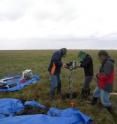Thawing permafrost likely will accelerate global warming
Up to two-thirds of Earth's permafrost likely will disappear by 2200 as a result of warming temperatures, unleashing vast quantities of carbon into the atmosphere, says a new study by the University of Colorado Boulder's Cooperative Institute for Research in Environmental Sciences. The carbon resides in permanently frozen ground that is beginning to thaw in high latitudes from warming temperatures, which will impact not only the climate but also international strategies to reduce fossil fuel emissions, said CU-Boulder's Kevin Schaefer, lead study author. "If we want to hit a target carbon dioxide concentration, then we have to reduce fossil fuel emissions that much lower than previously thought to account for this additional carbon from the permafrost," he said. "Otherwise we will end up with a warmer Earth than we want."
The escaping carbon comes from plant material, primarily roots trapped and frozen in soil during the last glacial period that ended roughly 12,000 years ago, he said. Schaefer, a research associate at CU-Boulder's National Snow and Ice Data Center, an arm of CIRES, likened the mechanism to storing broccoli in a home freezer. "As long as it stays frozen, it stays stable for many years," he said. "But if you take it out of the freezer it will thaw out and decay."
While other studies have shown carbon has begun to leak out of permafrost in Alaska and Siberia, the study by Schaefer and his colleagues is the first to make actual estimates of future carbon release from permafrost. "This gives us a starting point, and something more solid to work from in future studies," he said. "We now have some estimated numbers and dates to work with."
The new study was published online Feb. 14 in the scientific journal Tellus. Co-authors include CIRES Fellow and Senior Research Scientist Tingjun Zhang from NSIDC, Lori Bruhwiler of the National Oceanic and Atmospheric Administration and Andrew Barrett from NSIDC. Funding for the project came from NASA, NOAA and the National Science Foundation.
Schaefer and his team ran multiple Arctic simulations assuming different rates of temperature increases to forecast how much carbon may be released globally from permafrost in the next two centuries. They estimate a release of roughly 190 billion tons of carbon, most of it in the next 100 years. The team used Intergovernmental Panel on Climate Change scenarios and land-surface models for the study.
"The amount we expect to be released by permafrost is equivalent to half of the amount of carbon released since the dawn of the Industrial Age," said Schaefer. The amount of carbon predicted for release between now and 2200 is about one-fifth of the total amount of carbon in the atmosphere today, according to the study.
While there were about 280 parts per million of CO2 in Earth's atmosphere prior to the Industrial Age beginning about 1820, there are more than 380 parts per million of carbon now in the atmosphere and the figure is rising. The increase, equivalent to about 435 billion tons of carbon, resulted primarily from human activities like the burning of fossil fuels and deforestation.
Using data from all climate simulations, the team estimated that about 30 to 60 percent of Earth's permafrost will disappear by 2200. The study took into account all of the permanently frozen ground at high latitudes around the globe.
The consensus of the vast majority of climate scientists is that the buildup of CO2 and other greenhouse gases in Earth's atmosphere is the primary reason for increasingly warm temperatures on Earth. According to NOAA, 2010 was tied for the hottest year on record. The hottest decade on record occurred from 2000 to 2010.
Greater reductions in fossil fuel emissions to account for carbon released by the permafrost will be a daunting global challenge, Schaefer said. "The problem is getting more and more difficult all the time," he said. "It is hard enough to reduce the emissions in any case, but now we have to reduce emissions even more. We think it is important to get that message out now."
Source: University of Colorado at Boulder
Other sources
- Permafrost in name only — thaw adds to warmingfrom MSNBC: ScienceThu, 17 Feb 2011, 22:30:18 UTC
- Thawing permafrost will release carbonfrom UPIWed, 16 Feb 2011, 23:00:46 UTC
- Thawing permafrost likely will accelerate global warmingfrom Science BlogWed, 16 Feb 2011, 20:30:40 UTC
- Thawing permafrost likely will accelerate global warming, study findsfrom Science DailyWed, 16 Feb 2011, 19:31:33 UTC
- Thawing permafrost likely will accelerate global warmingfrom PhysorgWed, 16 Feb 2011, 18:30:32 UTC
